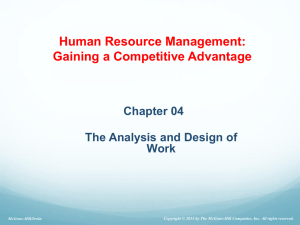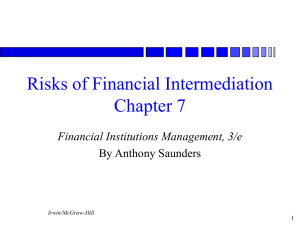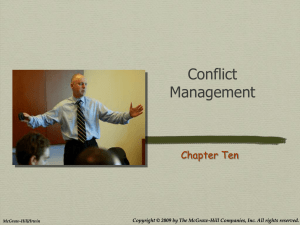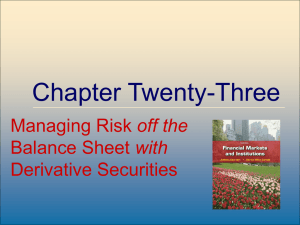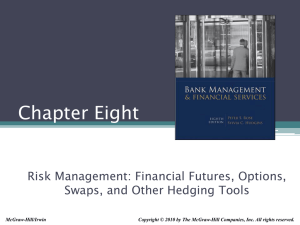Irwin/McGraw-Hill
advertisement
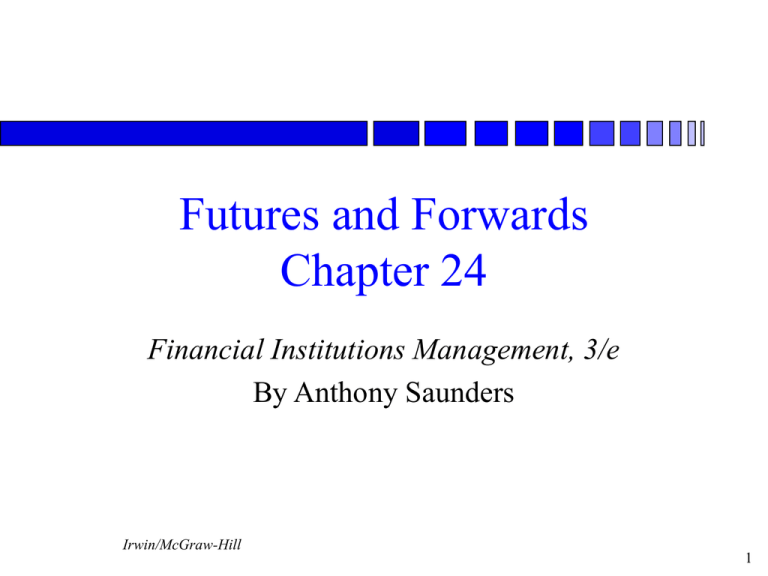
Futures and Forwards Chapter 24 Financial Institutions Management, 3/e By Anthony Saunders Irwin/McGraw-Hill 1 Futures and Forwards Second largest group of interest rate derivatives in terms of notional value and largest group of FX derivatives. • Swaps are the largest. Rapid growth of derivatives use has been controversial • For example, Orange County, California. Irwin/McGraw-Hill 2 Spot and Forward Contracts Spot Contract • Agreement at t=0 for immediate delivery and immediate payment. Forward Contract • Agreement to exchange an asset at a specified future date for a price which is set at t=0. Irwin/McGraw-Hill 3 Futures Contracts Futures Contract • Similar to a forward contract except » Marked to market » Exchange traded (standardized contracts) » Lower default risk than forward contracts. Irwin/McGraw-Hill 4 Hedging Interest Rate Risk • Example: 20-year $1 million face value bond. Current price = $970,000. Interest rates expected to increase from 8% to 10% over next 3 months. • From duration model, change in bond value: P/P = -D R/(1+R) P/ $970,000 = -9 [.02/1.08] P = -$161,666.67 Irwin/McGraw-Hill 5 Example continued:Naive hedge • Hedged by selling 3 months forward at forward price of $970,000. • Suppose interest rate rises from 8%to 10%. $970,000 $808,333 = $161,667 (forward (spot price price) at t=3 months) • Exactly offsets the on-balance-sheet loss. • Immunized. Irwin/McGraw-Hill 6 Hedging with futures Futures used more commonly used than forwards. • Microhedging » Individual assets. • Macrohedging » Hedging entire duration gap. • Basis risk » Exact matching is uncommon. Irwin/McGraw-Hill 7 Routine versus Selective Hedging • Routine hedging: reduces interest rate risk to lowest possible level. » Low risk - low return. • Selective hedging: manager may selectively hedge based on expectations of future interest rates and risk preferences. Irwin/McGraw-Hill 8 Macrohedging with Futures • Number of futures contracts depends on interest rate exposure and risk-return tradeoff. E = -[DA - kDL] × A × [R/(1+R)] • Suppose: DA = 5 years, DL = 3 years and interest rate expected to rise from 10% to 11%. A = $100 million. E = -(5 - (.9)(3)) $100 (.01/1.1) = -$2.09 million. Irwin/McGraw-Hill 9 Risk-Minimizing Futures Position Sensitivity of the futures contract: F/F = -DF [R/(1+R)] Or, F = -DF × [R/(1+R)] × F and F = NF × P F Irwin/McGraw-Hill 10 Risk-Minimizing Futures Position • Fully hedged requires F = E DF(NF × PF) = (DA - kDL) × A Number of futures to sell: NF = (DA- kDL)A/(DF × PF) • Perfect hedge may be impossible since number of contracts must be rounded down. Irwin/McGraw-Hill 11 Basis Risk • Spot and futures prices are not perfectly correlated. • We assumed in our example that R/(1+R) = RF/(1+RF) • Basis risk remains when this condition does not hold. Adjusting for basis risk, NF = (DA- kDL)A/(DF × PF × b) where b = [RF/(1+RF)]/ [R/(1+R)] Irwin/McGraw-Hill 12 Hedging FX Risk • Hedging of FX exposure parallels hedging of interest rate risk. • If spot and futures prices are not perfectly correlated, then basis risk remains. • In order to adjust for basis risk, we require the hedge ratio, h = St/ft • Nf = (Long asset position × h)/(size of one contract). Irwin/McGraw-Hill 13 Estimating the Hedge Ratio The hedge ratio may be estimated using ordinary least squares regression: St = a + bft + Ut The hedge ratio, h will be equal to the coefficient b. The R2 from the regression reveals the effectiveness of the hedge. Irwin/McGraw-Hill 14 Hedging Credit Risk More FIs fail due to credit-risk exposures than to either interest-rate or FX exposures. In recent years, development of derivatives for hedging credit risk has accelerated. • Credit forwards, credit options and credit swaps. Irwin/McGraw-Hill 15 Credit Forwards Credit forwards hedge against decline in credit quality of borrower. • Common buyers are insurance companies. • Common sellers are banks. • Specifies a credit spread on a benchmark bond issued by a borrower. » Example: BBB bond at time of origination may have 2% spread over U.S. Treasury of same maturity. Irwin/McGraw-Hill 16 Credit Forwards • SF defines credit spread at time contract written • ST = actual credit spread at maturity of forward Credit Spread Credit Spread Credit Spread at End Seller Buyer ST> SF Receives Pays (ST - SF)MD(A) (ST - SF)MD(A) SF>ST Pays (SF - ST)MD(A) Receives (SF - ST)MD(A) Irwin/McGraw-Hill 17 Futures and Catastrophe Risk CBOT introduced futures and options for catastrophe insurance. • Contract volume is small but rising. • Catastrophe futures to allow PC insurers to hedge against extreme losses such as hurricanes. • Payoff linked to loss ratio Irwin/McGraw-Hill 18 Regulatory Policy Require a bank to • Establish internal guidelines regarding hedging. • Establish trading limits. • Disclose large contract positions that materially affect bank risk to shareholders and outside investors. • Beginning in 2000, derivative positions must be marked-to-market. Irwin/McGraw-Hill 19




